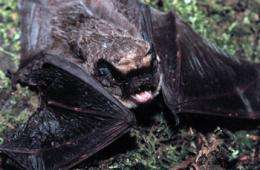We're off then: The evolution of bat migration

(PhysOrg.com) -- Not just birds, but also a few species of bats face a long journey every year. Researchers at Princeton University in the U.S. and at the Max Planck Institute for Ornithology in Radolfzell, Germany studied the migratory behaviour of the largest extant family of bats, the so-called "Vespertilionidae" with the help of mathematical models. They discovered that the migration over short as well as long distances of various kinds of bats evolved independently within the family.
Most people know the term of "migrating bird" but "migrating bat" is not well established. However, some bat species migrate every year long or short distances. Whereas birds migrate to exploit seasonal food resources, the majority of bats migrate with the intention to find better hibernating conditions.
In Europe about 30 percent and in North America around 45 percent of bird species migrate; the migration of bats however is a rather rare phenomenon. Only about three percent of the approximately 1,000 bat species migrate, of those less than 0.016 percent migrate further than 1,000 kilometres. The vast majority of bats living in temperate zones hibernate during the winter as a result of food shortage at this time.
Together, researchers of the University of Princeton in the U.S. and the Max Planck Institute for Ornithology analyzed the genealogical tree of bats on the basis of their migratory behaviour. They are confining themselves to only the family of the "Vespertilionidae", also called the vespertilionid bats, which includes 316 species or about a third of all bat species. Of about 32 migrating bat species, 23 are part of this family. Eleven of those migrate over long distances greater than 1,000 kilometres. The remaining twelve species only fly short distances that vary between 100 to 1,000 kilometres.
The researchers discovered that the migratory behaviour over long and short distances evolved repeatedly and for the most part independently within the family of vespertilionid bats. Kamran Safi, one of the authors of the study says: "according to the model, the probability for the vespertilionid bats to loose or gain their residential habitat is the same as becoming a short or long distance migrant". The migratory behaviour of bats could be more complex than previously assumed. The evolution as well as the loss of the migratory behaviour is probably based on the fast evolutionary adaptation that is caused by climate change or changes in the social life of the bat.
The scientist of the Max Planck Institute says: "We assume that the evolution of migratory behaviour in the vespertilionid bats is an answer to sinking temperatures in their habitats, which made a temporary migration into warmer areas necessary". In contrast, for the migratory behaviour of birds it is generally hypothesized that tropical species expand to different areas. The evolution of migratory behaviour in bats enabled access to new resources and as a result, the density of the bats increased rapidly.
Most of the verspertilionidae were originally from the temperate zone and not from the tropics. In addition, researchers discovered that there is a correlation between migration and roost use as well as between migration and geographic distribution. Furthermore tree roosting bats are more likely to migrate than cave roosting species. A possible reason for this behaviour is the difficulty for bats to find suitable hibernating conditions in trees.
Original work:
More information: Isabelle-Anne Bisson, Kamran Safi, Richard A. Holland, Evidence for Repeated Independent Evolution of Migration in the Largest Family of Bats. PLoS ONE 4(10): e7504. October 21st, 2009. doi:10.1371/journal.pone.0007504
Provided by Max-Planck-Gesellschaft (news : web)















